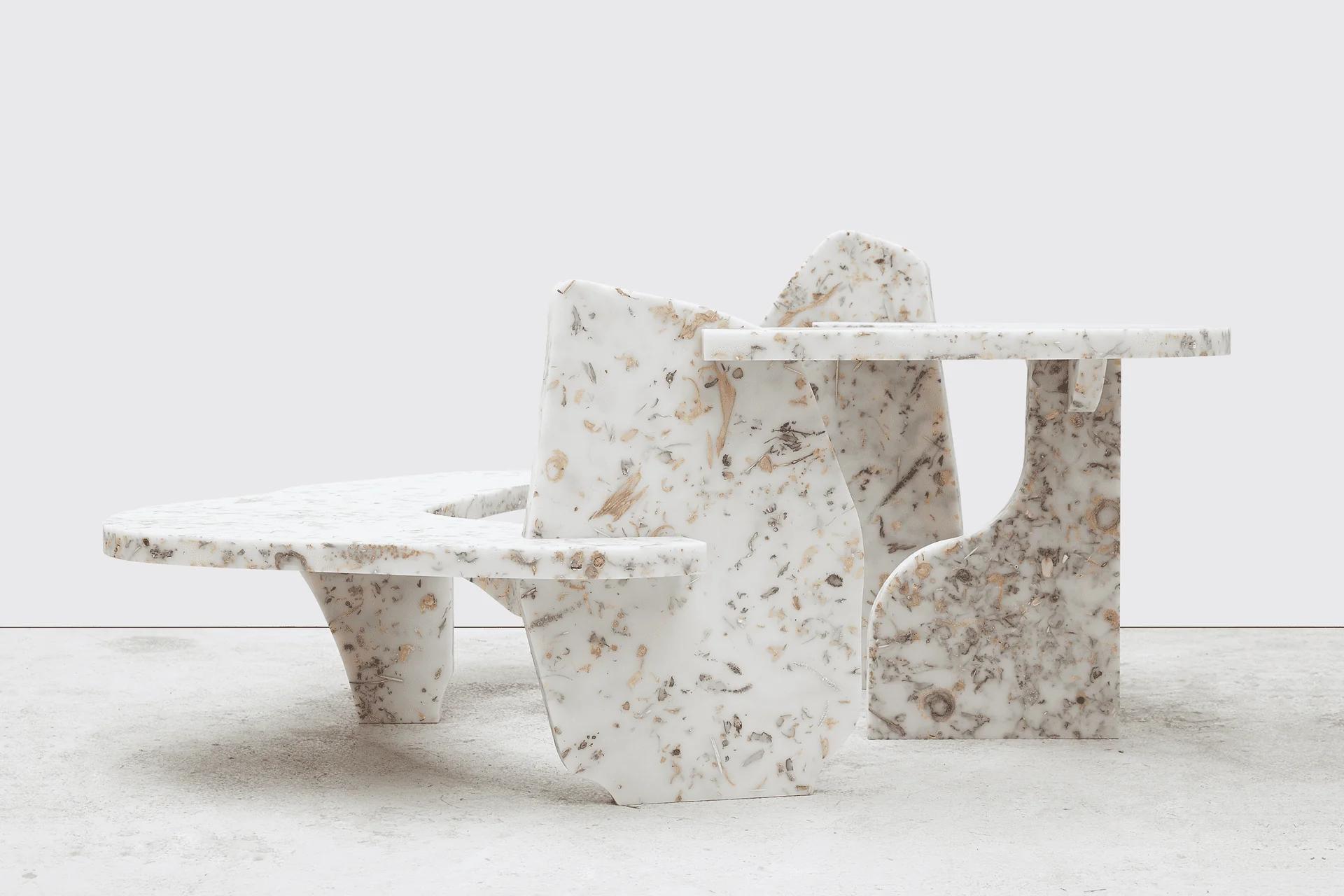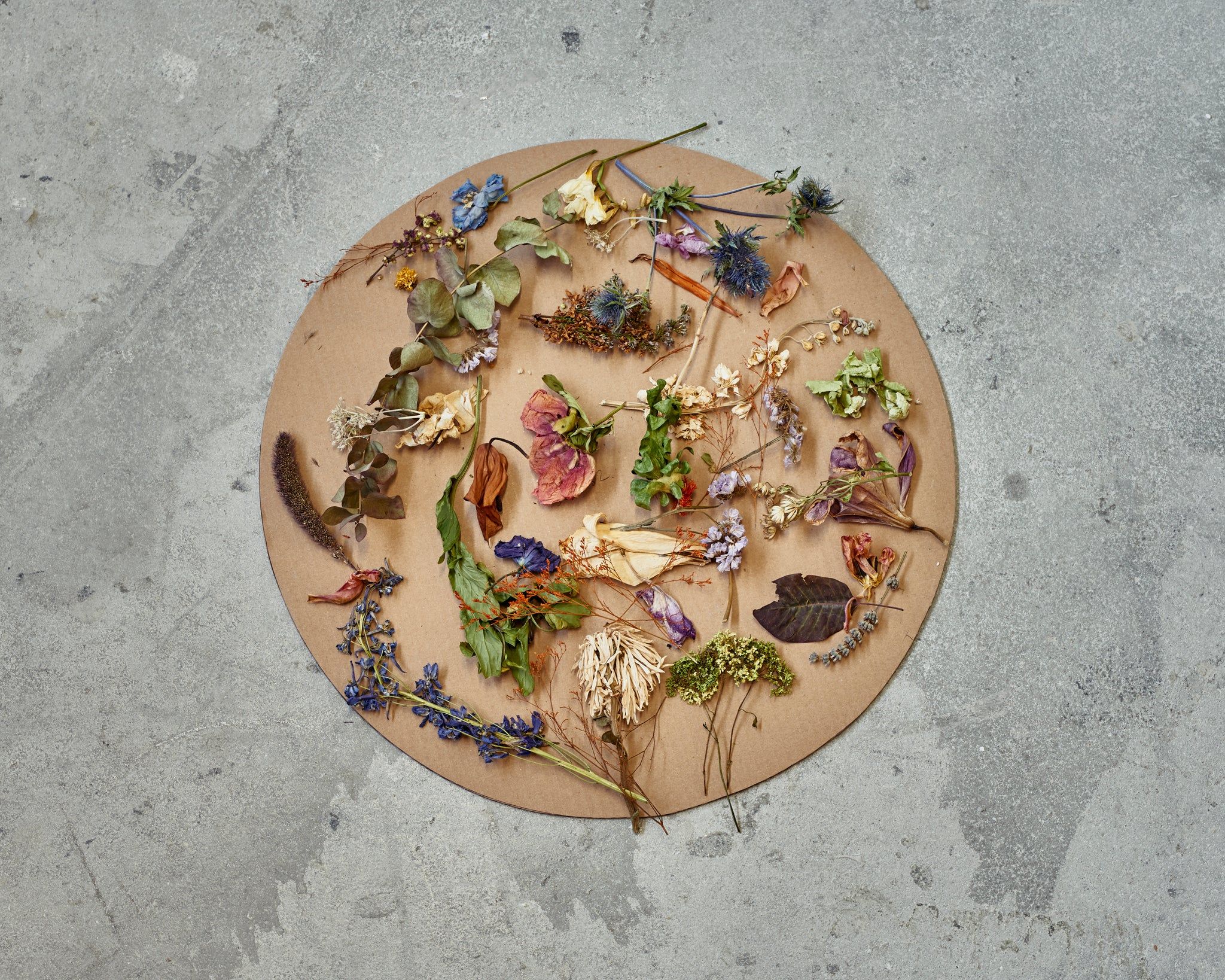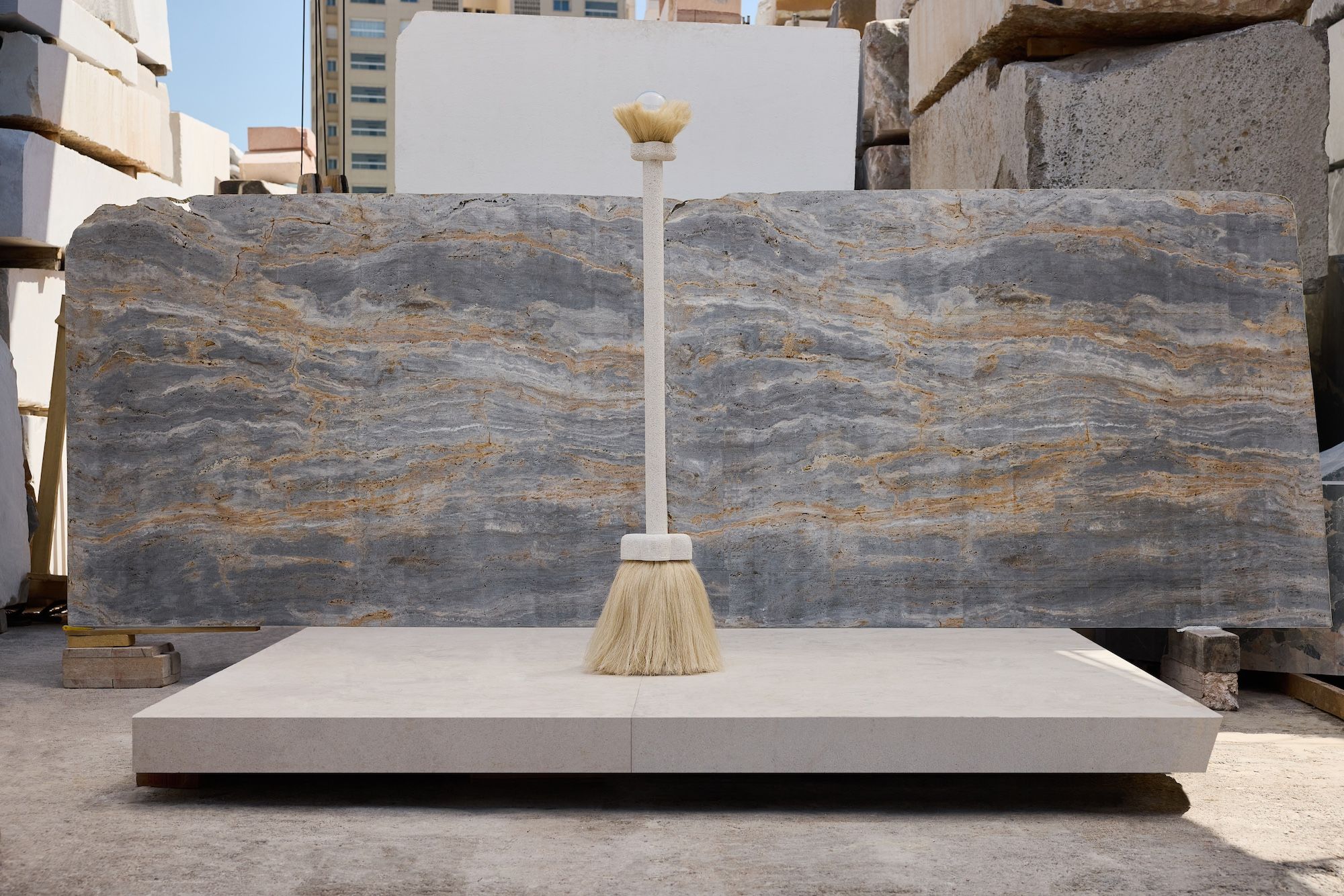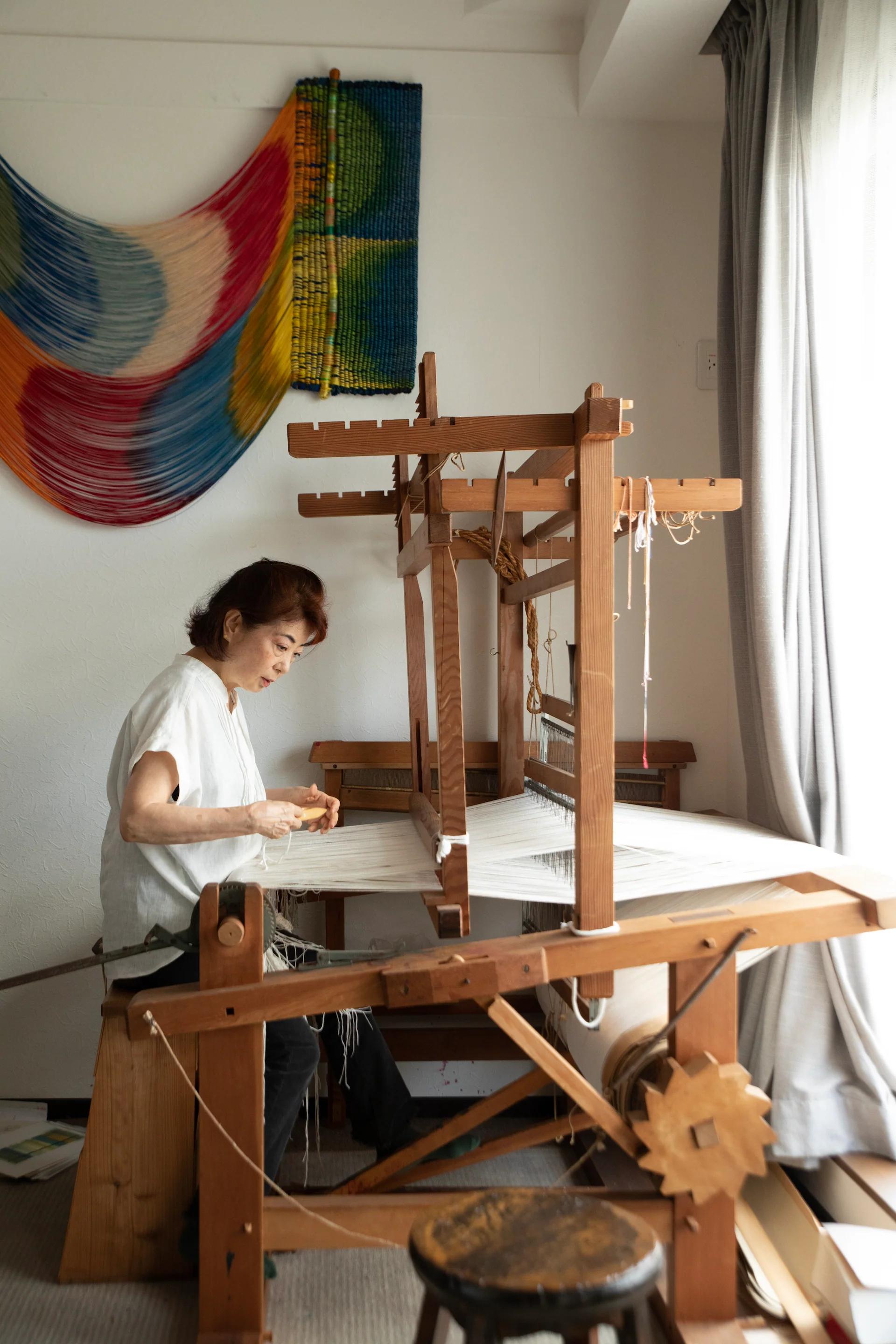HOW TO MAKE IT JUNE 26 2020
by Anna Carnick
For designer Marcin Rusak, nature is both the medium and the message

MARCIN RUSAK/ PERMA 5, FOR SARAH MYERSCOUGH GALLERY
Photo © Marcin Rusak Studio / Sarah Myerscough Gallery

DETAIL FROM MARCIN RUSAK’S FLORA COLLECTION
Photo © Pim Top courtesy of Marcin Rusak Studio
Picture this: A beautiful tangle of flowers, suspended inches below the surface of a dark pond, apparently so surprised to find themselves submerged that they’ve stopped, mid-motion, frozen in time. The effect is strange but familiar—life and vitality paused for our indulgent observation. At any moment, it seems, a petal or stem might just break through.
Now imagine a milky stone, full of fossilized remains that form marble-like veins, a universe of organic shapes and colors peeking out from within. A few wild specimens, caught mid-escape between stone and air, will soon dry, dissolve, and fall to the ground. What earth once gave she now takes back.

MARCIN RUSAK/ PERMA 5, FOR SARAH MYERSCOUGH GALLERY
Photo © Marcin Rusak Studio / Sarah Myerscough Gallery
These scenes—and others like them—are central to the practice of experimental Polish designer Marcin Rusak, for whom nature is both medium and message. Frequently crafting materials and objects from decaying organic elements, his designs are imbued with a life all their own, their ambiguous states a core component. They act as poetic markers to tackle timely and timeless topics, from sustainability and transformation to consumer culture, beauty, and beyond.
For the ongoing series Flora (2015-) and Perma (2018-), Rusak sources discarded flowers from the floral industry, extending their life cycles by combining petals, stems, and buds in molded resin to create a solid composite material. These amalgamations feature wild landscapes and botanical cross-sections, often calling to mind the depth, color, and light associated with the Flemish masters. In the case of Flora, the material becomes lighting and furniture; in Perma, the resulting planes are CNC-cut into hand-drawn shapes and assembled into large, sculptural, furniture-like objects.

MAKING OF RUSAK'S FLORA COLLECTION
Photo © Pim Top, courtesy of Marcin Rusak Studio
In both series, the material itself is at once permanent and evolving; simultaneously acts of preservation whereby nature is “stretched into eternal blossom,” as Rusak observes, and dynamic reflections on transformation. Within these microenvironments, while much is stable, some organic tissue continues to evolve over time. With Flora, bacteria introduced during production causes some of the flowers within to mutate, shrink, and vanish, until they’re ultimately replaced by negative space. With Perma, as the bio-resin planes are machined, occasionally, a flower is sliced and its insides exposed at the surface; these dry up and sooner or later disappear as well, leaving behind tiny cavities. As London gallerist Sarah Myerscough explains, “These fleeting elements are just as valuable as those which remain; they poetically reflect the mutability of life.”
To hear Rusak tell it, “I think of these natural materials as media to talk about the importance of nature in our lives, but also the meaningless consumption that follows trends and irresponsible habits of replacing over maintaining. [I’m] creating a language, a certain aesthetic of decay, as a valuable aspect for the works to exist in the first place. Visualising that decay, we can behold a certain type of beauty connected to transformation and make a break with the notion that what decays needs to be thrown away. In that sense, the aesthetic becomes a function.”
Rusak’s fascination with the natural world and our evolving relationship to it began early. He was born and raised in central Warsaw to a family of retired flower growers. The multigenerational family business, first begun in 1900, closed around the time of his birth in the late ’80s. Rusak spent his youth surrounded by the remnants of that legacy.

MARCIN RUSAK IN HIS STUDIO
Photo © Pim Top courtesy of Marcin Rusak Studio
“After the business closed,” Rusak recalls, “my family home remained surrounded by greenhouses and beautiful gardens that cultivated over 2000 species of plants and trees. But my everyday environment was a post-industrial variation on such a landscape that had nothing to do with the romantic notion of growing up surrounded by fields of flowers; it was a landscape of zinc planters, steel pipes, machines, pumps, and other obscure structures. The memory of weeds, decayed plants, dry soil, the architecture of the abandoned machinery was something that helped me form the foundations for my present interests.”
That inspiration is evident throughout his practice today. In addition to Flora and Perma, Rusak—now dividing his time between Warsaw and London—has preserved leaves in metallic cocoons (Protoplasting Nature) and composed vases from organic waste that melt, collapse, and rot (Perishable Vases), among other experiments. Commenting on consumption and material culture through arresting, lyrical imagery, his work has quickly caught the attention of many of the design world's connoisseurs.

MARCIN RUSAK HOLDING FLOWERS DISCARDED FROM THE FLORAL INDUSTRY
Photo © Mathijs Labadie courtesy of Marcin Rusak Studio
As Myerscough notes, though young, Rusak’s practice is “incredibly mature and considered—the kind that many strive to achieve over decades.” She goes on, “He raises questions about consumerism and waste engendered by global markets and logistics; he also mines our perceptions of beauty and its transience… Not only does Marcin recall—and revitalize—our long obsession with flower motifs in furniture decoration… he also recalls his own family history. Marcin's ability to confidently weave so many complex conceptual and aesthetic threads together makes him, above all, an accomplished storyteller.”
In recent months, in light of the pandemic’s impact on trade across the globe, and in particular the spike in waste from the floral industry, Rusak has begun exploring ways to respond quickly and thoughtfully. He is investigating new potential paths within the industry, possibly in partnership with Royal Flora Holland.

THE MAKING OF MARCIN RUSAK’S FLORA COLLECTION
Photo © Pim Top courtesy of Marcin Rusak Studio
“On one hand,” he says, “there are tons of flowers being burned and destroyed by massive businesses trying to protect their operations. With economic crises ahead of us, tendencies to purchase secondary needs [e.g. flowers] are much lower. On the other hand, our lives have been physically and geographically restricted, and our desire to be in touch with nature is greater. Now more than ever, we should reevaluate our purchasing habits and think if it is really necessary to buy flowers that come from such far away places. They need to be transported by planes and require a gigantic industrial support chain. I am not referring to eliminating workplaces within the chain, but adjusting to the new reality, which should focus on vernacular, locally grown and sourced products.”
“My dream garden,” he concludes, “would consist only of forgotten weeds and local plants. There is such purity in nature that belongs to specific physical spaces. If these notions could be translated into what we decide to purchase through flower stores, there is a chance that the flowers would [be] destroyed on a much smaller scale.” Ultimately, as Rusak notes both through his design and words, “The world is made of events, not things.” ◆
Rusak’s Perma collection is available throughSarah Myerscough Gallery.
To learn more, visit Marcin Rusak'swebsite.


